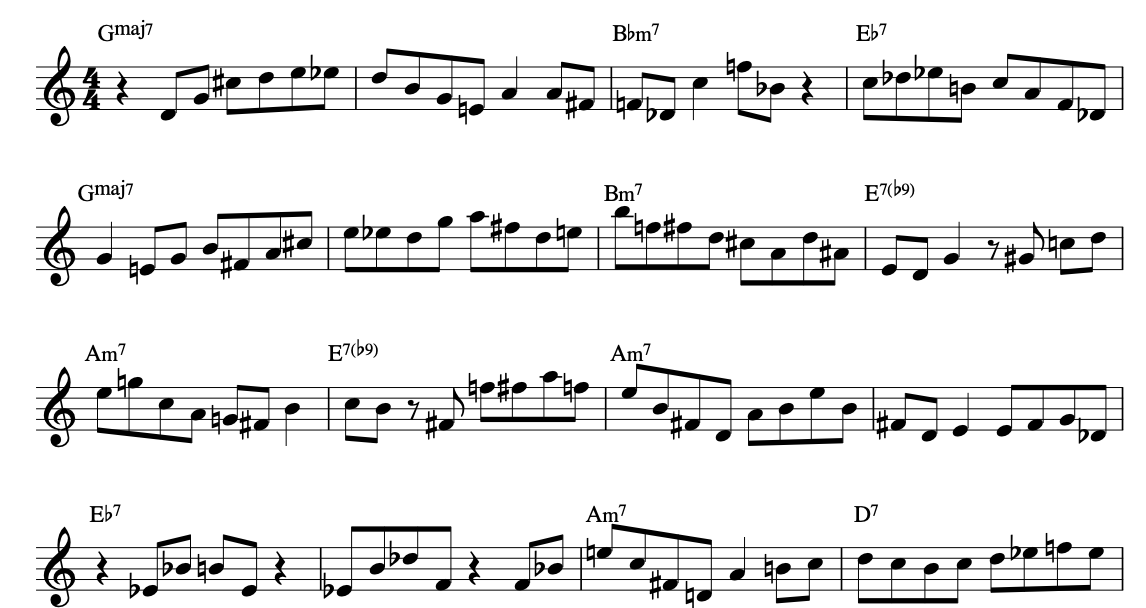After reflecting upon a lesson I gave last week to a beginning jazz student, I came to realize a simple truth about what it takes to improvise. I’d like to share my thoughts with you.
No matter what genre of music you improvise in, there are four essential components you rely upon to create music spontaneously. This applies whether you’re a novice or an accomplished artist (or somewhere in between). These four things are:
- Impetus
- Imagination
- Control
- Risk
Allow me to elaborate.
Impetus
You must have something that moves you along, that gives life to your creative impulse.
Time, rhythm, and feel are primary, and are more basic and fundamental than pitch itself. There can be music without pitch, but not without rhythm. In jazz pedagogy, there is often too much of an emphasis for the beginning improviser on which notes to play, with little emphasis on the thing that actually gives life to these notes.
Many of these beginners feel deep frustration when they know a particular group of pitches quite well (like the blues scale, for example) but can’t seem to make any music with it.
This is a rhythmic issue. They need to develop and learn to rely upon their pulse/rhythm/ feel impetus.
Master improvisers are not really thinking a lot about which notes to play and how to connect them when they’re in the middle of a solo. They’re mostly following their rhythmic instincts (which are, of course, integrated effectively into their harmonic/melodic knowledge and skills).
If you’re a novice improviser, spend lots and lots of time developing this first. I’ve written an article that will help you along with this.
Imagination
You have to be able to conceive melodic ideas (pitch, rhythm, inflection, articulation, dynamics…coming together seamlessly).
In essence, there has to be meaning to what you play (it has to mean something to you!) For this to happen, you need to work towards cultivating a vast musical imagination.
If you’re a beginning student of jazz, for example, you must listen, listen, listen to great jazz recordings! But don’t just listen passively. Make it a point to listen to a favorite improvised solo to the point that you can sing it clearly, accurately and easily. Then sing or hum this solo, making slight variations. This is just one thing you can do to develop your imagination.
You can also practice singing along with jazz recordings (or backing tracks) discovering and cultivating your imagination. Again, make the rhythmic impetus primary.
Control
You have to be able to carry out what you imagine and feel (impetus).
This is where so much of the hard work comes in. You must not only be able to have knowledge of chords, scales, articulations and forms, but also, you must have the skills on your instrument to play them…in real time, with little trouble or thought.
Some of the novice improvisers I teach simply need to spend more time mastering the basics of their instrument (technique, sound production, etc.) You also need to work towards hearing what you can play (scales, chords, melodic patterns, etc.), and understanding how it relates to harmony, melody, form, etc. This is also a component in developing your imagination (see above).
Risk
You must be willing to step into the unknown.
Without this willingness, you’ll never allow yourself the joy of spontaneous musical creation. Improvisation, by definition, involves risk. It involves being in the moment, faced with no exact script, and trusting your muse.
But let this be a fun thing, a human thing. After all, when you’re speaking, you’re improvising, constantly changing and following your thoughts. You do it naturally (through lots and lots of practice). Improvising music isn’t so different.
Great improvisers are not only unafraid of risk, but also, welcome it. They ride upon the unknown like a huge, beautiful wave.
In the study of jazz improvisation there can often be an imbalance of these 4 components. Perhaps too much of an emphasis on technical skills at the expense of developing imagination. Perhaps rarely exploring and pushing the limits of risk taking. Perhaps gaining great technical control over a very narrow rhythmic and melodic imagination.
Whatever the case, it’s always possible to reflect upon your progress, redirect your efforts, change your plan, and improve your playing.
